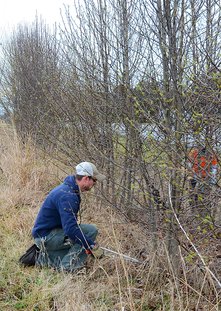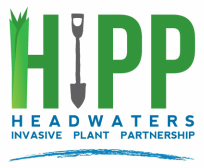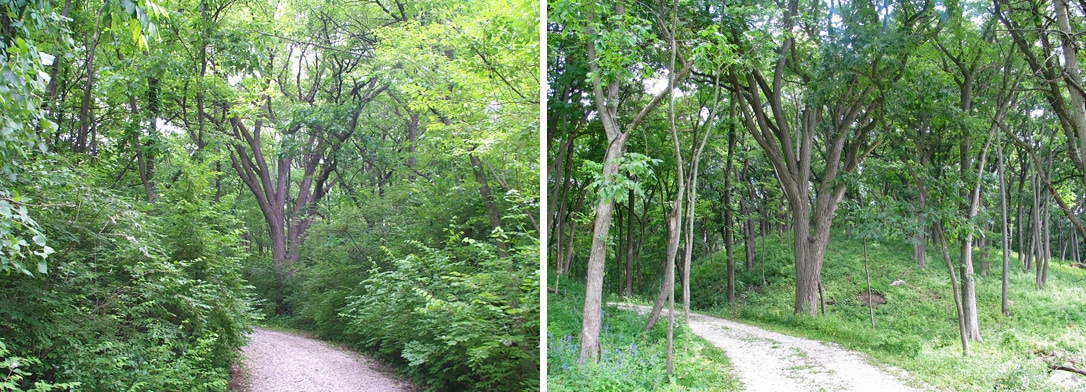Stop the Spread! Plant Natives Instead
.
 Invasive callery pear at Champaign County Forest Preserve's Buffalo Grove Prairie
Invasive callery pear at Champaign County Forest Preserve's Buffalo Grove Prairie
What are those white trees in downtown Champaign?
Have you noticed the growing number of white tree trunks in downtown Champaign, Illinois? This exhibit was created by the Headwaters Invasive Plant Partnership to bring attention to the rapid spread of invasive plants in our area.
Invasive plants are aggressive and quickly displace native plants, damaging the environment for wildlife and humans. And they cost the US billions to control.
Where do invasives come from?
Invasive plants were often introduced from other countries as well-intended landscape choices. Unfortunately, many garden stores sell invasive plants. Invasives may also be lurking in your yard already. If you have a plant popping up everywhere—or spreading like crazy—it might just be invasive!
These sneaky plants ESCAPE from your yard and invade our parks and forest preserves. Birds eat their fruit and deposit the seeds near and far.
How can you help?
You can help keep your property and public natural areas healthy by taking these steps:
2. Does this plant grow rapidly?
3. Does it establish itself rapidly?
4. Is it hard to contain to an area?
5. What is an alternative plant (especially a native one)?
Have you noticed the growing number of white tree trunks in downtown Champaign, Illinois? This exhibit was created by the Headwaters Invasive Plant Partnership to bring attention to the rapid spread of invasive plants in our area.
Invasive plants are aggressive and quickly displace native plants, damaging the environment for wildlife and humans. And they cost the US billions to control.
Where do invasives come from?
Invasive plants were often introduced from other countries as well-intended landscape choices. Unfortunately, many garden stores sell invasive plants. Invasives may also be lurking in your yard already. If you have a plant popping up everywhere—or spreading like crazy—it might just be invasive!
These sneaky plants ESCAPE from your yard and invade our parks and forest preserves. Birds eat their fruit and deposit the seeds near and far.
How can you help?
You can help keep your property and public natural areas healthy by taking these steps:
- Educate yourself about invasive plants in east central Illinois.
- Make informed landscaping choices—avoid invasives and plant natives. HIPP has a brochure featuring beautiful native alternatives to some of the worst invasive plants, many of which may be in your yard right now.
- When you shop for plants, ask the right set of questions:
2. Does this plant grow rapidly?
3. Does it establish itself rapidly?
4. Is it hard to contain to an area?
5. What is an alternative plant (especially a native one)?
- After a hike (or between destinations) clean your shoes and clothing to remove hitchhiking seeds.
- Remove invasives on your property by digging them up at the roots before they flower.
- Volunteer with local conservation groups removing invasives. Their leaders will show you which plant is which. See our calendar of upcoming workdays.
Before & After: Invasive Honeysuckle Removal
Invasive plants can dramatically change our landscape. At left, a wooded area in northern Illinois is overtaken by invasive bush honeysuckle, completely shading the ground and crowding out native plants. At right, the same area is seen after the hard work of removing the honeysuckle. The open forest floor can now support native wildflowers and a new generation of young trees. Photos courtesy of the Forest Preserve District of DuPage County.
Invasive plants can dramatically change our landscape. At left, a wooded area in northern Illinois is overtaken by invasive bush honeysuckle, completely shading the ground and crowding out native plants. At right, the same area is seen after the hard work of removing the honeysuckle. The open forest floor can now support native wildflowers and a new generation of young trees. Photos courtesy of the Forest Preserve District of DuPage County.


